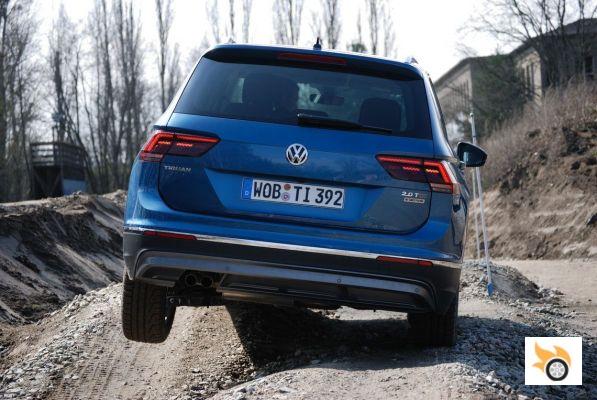Its predecessor, based on the Golf VI, reached a Spanish market share of 10.7%, and of those, less than 10% were sold with the off-road package. This time, Volkswagen Spain believes that they will get up to 30% of sales of that version, and the overwhelming majority will have the normal configuration, to go on road. At the end of the day, that's what most people demand, an SUV for on-road driving, and almost all of them are ordered with front-wheel drive.
The Volkswagen Tiguan is the brand's first SUV to use the MQB platform.
In principle we are facing a completely positive renewal of the car: the new design makes it more livable and able to load, the engines are more efficient, has many more technological solutions, is more comfortable and does not retreat in terms of ability to leave the asphalt. If it has any downsides, I haven't found any that are of sufficient importance so far.
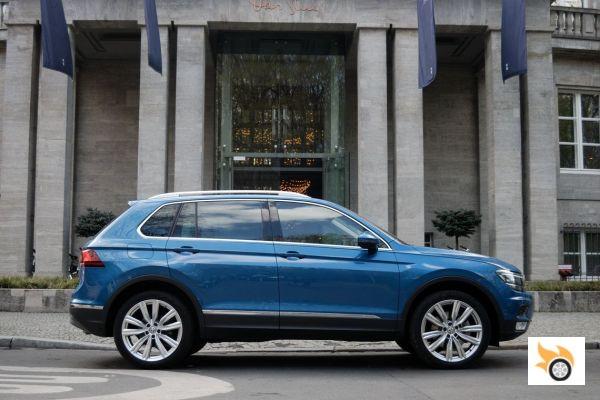
Optimised design
Volkswagen is applying the proportional canons allowed by the MQB platform: it's longer, wider and lower, but wider. The body has grown by 60 mm in length, but the wheelbase has increased by 77 mm by taking space away from the overhangs. In other words, the axles are further apart and closer to the ends. In terms of interior space, the increased wheelbase translates into 30 mm for the rear occupants, and the best boot among SUVs of 4.65 metres or less, beating the Honda CR-V. For those who need a 5+2 seater, you can wait until next year, there will be a larger version.
The load capacity with the rear seats in their rearmost position is 520 litres, but you can gain up to 615 litres. The rear bench seat has two longitudinal adjustment zones (up to 18 cm, previously 16 cm), and the seats can be folded down in a 60:40 or 40:20:40 ratio, depending on the version. The front occupant's seat can also be folded down if you want to carry a very long object. The maximum capacity is 1,655 litres.
LED headlights are standard on the Highline, the rest use bi-xenon as standard.
You can have three exterior looks: Onroad, Offroad and R-Line. The latter is the sportiest, but the least suitable for leaving the tarmac, with 19- or 20-inch wheels. Overall, the range has three 17″ wheel designs (two of them with hubcaps), two 18″, two 19″ and three 20″. On the road I rode with Kapstadt (20″) rims, and on the 4×4 track with the Kingston (18″) ones. As for the range of colors, it is very rich, it has 14 shades available between solid, metallic and pearlescent.
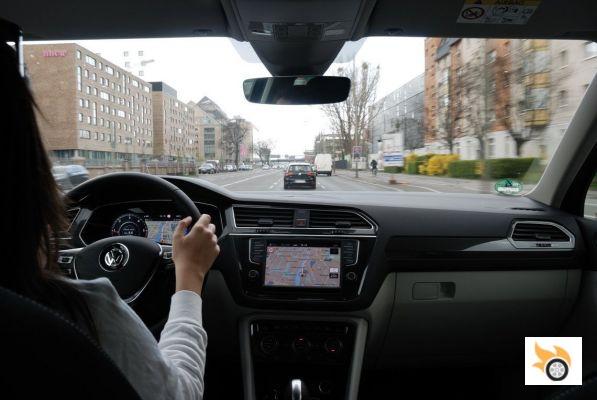
Inside the Tiguan offers us a very driver-oriented interior, with a higher driving posture, but it is not perceived as very high. The seats have been raised 8 cm compared to the previous model, and although the roof is lower, the habitability has not been compromised. The rear seats can accommodate three adults, there's plenty of legroom, and the width is adequate for a non-anorexic to sit in the middle. Optionally you can have a three-zone climate control, two in the front and one in the rear.
The seats, very comfortable, can have eight different upholsteries, with three being leather. In its top specification, the driver's seat has four electric adjustments and massage function, as well as heating. It has multiple spaces to leave objects, several of them upholstered in non-slip rubber, as usual in this brand. Other amenities are the refrigerated glove box, the inductive mobile phone charger or the rear airplane type trays. We can consider it as an alternative to the Touran or the Golf SV.
I found the cabin to be very quiet, even with the 20-inch wheels and Pirelli Scorpion Verde tyres, driving at 200 km/h on the Autobahn. You start to notice the presence of air after 140 km/h, but I'd be lying if I said I found it annoying. As for the noise level of the 150 hp diesel engine, very restrained in all circumstances, the TDIs of the EA288 family don't even resemble the whites of their eyes compared to the pump injectors of the last decade. As a car, little to criticize, chapeau.
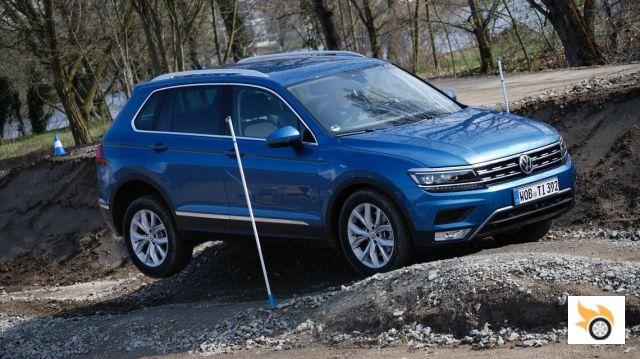
Wide range of engines, up to 240 bhp power
Those who value the Volkswagen Tiguan, can do so against premium models, as it offers more possibilities than the bulk of the generalist SUV C. The simplest engines are the 1.5-litre 1.0-litre engine. The simplest engines are the 1.4 TSI (125 hp) and 2.0 TDI (115 hp), which are always offered with front-wheel drive. In the SEAT Ateca the basic engines are a three-cylinder 1.0 TSI and a 1.6 TDI with similar power ratings, which are tighter. In the intermediate step has two engines 1.4 TSI and 2.0 TDI with 150 hp power.
Regarding the top of the range, you can have two 2.0 TSI engines of 180 and 220 hp, as well as the 2.0 TDI of 190 and 240 hp. The most powerful come with all-wheel drive as standard and DSG automatic transmission. Very few general SUVs exceed 200 hp power, especially if we talk about tankers. The offer is four-cylinder with turbo in any of the cases, and some are not available right now. I've only tried 150 hp TDI, with all-wheel drive and DSG automatic transmission. It seems to me a very adequate power level for most circumstances, and unlike some competitors with tighter engines, it has better bellows.
A plug-in hybrid version (GTE) may come later, but there won't be a natural gas one.
There is little to say about the gearbox, as well as the 4Motion system. The driver can choose how the latter behaves with a selector wheel, similar to the Touareg, with road, snow, off-road and custom off-road modes. It is possible to adjust the response of the different systems, including the suspension if the adaptive dampers (DCC) have been fitted. It has a descent assistant for very steep slopes, when driving off-road. It is not necessary to deactivate the stability control, when selecting the off-road mode its margin of intervention changes so as not to get in the way.
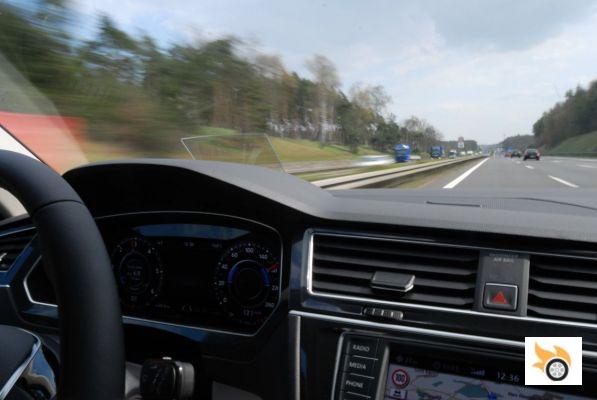
The road test took place in Berlin and surroundings, with a homogeneous mix of city, secondary roads and highway, but with no "interesting" curves to put the car in trouble. My presentation partner and I drove in a very similar way to normal people, in comfort, where we appreciated the comfort that the car transmits in any circumstance, even with the 20-inch rollers of the tested unit. The power is only used seriously on the highway.
You can also appreciate the differences between normal, sport or efficient driving mode, selectable by the driver, and customizable in the "Individual" mode. Personally I prefer the efficient mode, in which the DSG automatically selects neutral in those circumstances in which it is more efficient to drive in this way. In any case, fuel consumption was between 6.5 and 7 l/100 km, which isn't great, but it's not excessive either. The Tiguan's aerodynamic coefficient is 0.32, an improvement on the 0.37 of the previous model.
The new 100% digital dashboard, standard on the Sport (50% of expected sales) and Highline, optional on Advance for 700 euros, is highly customisable and requires a period of adaptation to get the most out of it. As for the HUD above the dashboard, it allows us to concentrate as much as possible on driving, having the most essential information in sight. And if we drive off-road, we can see valuable information on the main screen, such as the inclination of the bodywork or the coolant temperature. On a technological level the car is a real blast.
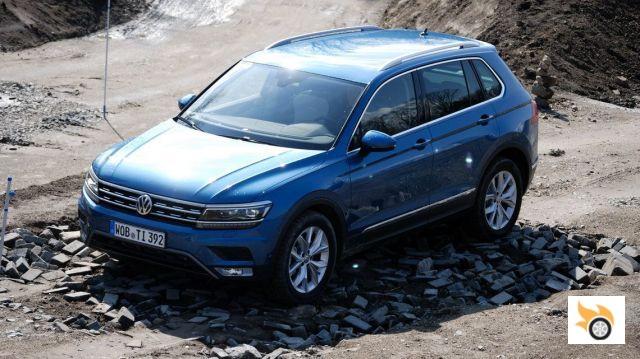
Testing its off-road abilities at Mellowpark
In addition to the road course, I tested the Tiguan on a Berlin circuit, Mellowpark, known to BMX bike and skater connoisseurs (see video). Volkswagen technicians prepared a circuit suited to the capabilities of the car, which without being very extreme, allows us to evaluate what it is capable of. Let's keep in mind at all times that the Tiguan is an SUV, a passenger car that has some off-road capabilities.
Here we journalists only tested the Tiguan Offroad, which has an angle of attack of 25.6 degrees (higher than the 16 degrees of the normal model), 20 degrees ventral and 24.7 degrees of exit. Suspension travel is the same, as is ground clearance (180 mm under the axles, or 200 mm under the chassis), but it's a tad taller, and the tracks are 7-8 mm narrower. Tuning further, the test was done with Tiguan 2.0 TDI DSG 4Motion (all-wheel drive) and Pirelli Sottozero winter road tires, with M+S capability (mud and snow) and 18 inches in diameter.
First gear with DSG gearbox is short enough to climb ramps without straining the engine.
The track has several ramps that reach an incline of 40%, which the Tiguan climbs effortlessly, but depending on the attack speed you may or may not give the underbody a touch. As the suspension travel is limited, if we don't give the elements time to work, the chassis will be very close to the ground. I only remember touching the underbody at one point, at the top of the steepest ramp. The descent is child's play, with the assist function, and there's no need to touch the pedals.
Apparently the Tiguan moves very confidently around the course, including the banked corners, which aren't there to see how much it can hold without tipping over, but to assess the turning radius. The Tiguan needs little room to turn, and the steering is very direct compared to a more traditional off-roader, like the Jeep Wrangler or SsangYong Rexton, which have a lot of gear reduction. We arrived at a delicate place, the passage through some obstacles of stones and wooden steps, where you have to make use of the four cameras in the car to know where we are going to pass. The views can be customized using different combinations of cameras.
The XDS system, which emulates a self-locking system on both axles, will prevent one wheel from spinning madly in the air while the opposite one is not under any force.
Just keep in mind that you have to go down the steps one by one, carefully, so as not to hit the underbody. In the moments when one wheel is suspended in the air we can see how not a single plastic part of the interior rattles due to the torsion. Thanks to the MQB platform and today's steels, a monocoque can be as good as a ladder chassis, but weighing much less. When doing weight transfers on the axles, more of the same, sounds nothing, the Tiguan proves to be solid enough: 28,000 Nm/degree with normal roof, and 25,000 Nm/degree with sunroof (like the tested versions).
The 4Motion system doesn't exactly sweat all the way, as no mud had formed and the tread of the winter tyres is effective in these circumstances. You can't intervene in the power distribution between axles, it's completely variable between 100/0 and 0/100. I asked Yvonne Laschinsky, who has worked on the chassis, why there is no selector to force a 50:50 split (which some competitors have). Her answer was that, as the 4Motion system is very quick, there is no need to force a split, it will always work as efficiently as possible.
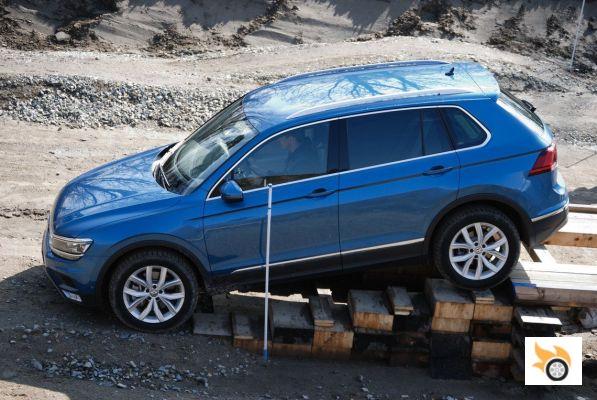
Take a walk on the tech side
As usual, the new Tiguan brings the latest bark in infotainment with multiple connectivity capabilities. As my mobile phone is very simple, I couldn't take advantage of its full potential, but with my partner's iPhone some additional functions could be used. The multimedia systems are gaining complexity in this order: Composition Touch, Radio Composition Colour, Composition Media, Discover Media and Discover Pro. At the highest level you have a 4G SIM card, with added services that will cost money from the first year onwards.
The Car-Net Security & Service services can be very interesting for those who can and want to pay for them.
The system allows you to see a GoPro camera on the main screen (useful if you have a trailer), manipulate the multimedia system with a tablet from the back, locate the car from the mobile phone, and even know if the person who has borrowed the car wants to run or go to an unauthorized area. This is ideal for trolldad who give the use of the Tiguan to children in their twenties and do not have a high rating of sincerity. So you know, if you go to the riding school and put it up to 150 km/h, your actions will not go unpunished.
More than one will wonder if all these systems are upgradeable, so I asked Rene Bondzio, a specialist on the subject. He said that although the devices themselves (hardware) will not be upgraded, it will be possible to upgrade the software in the future, although some upgrades will be paid for. In principle the system is compatible with Android Auto, Apple Carplay and Mirrorlink, and will not become obsolete quickly.
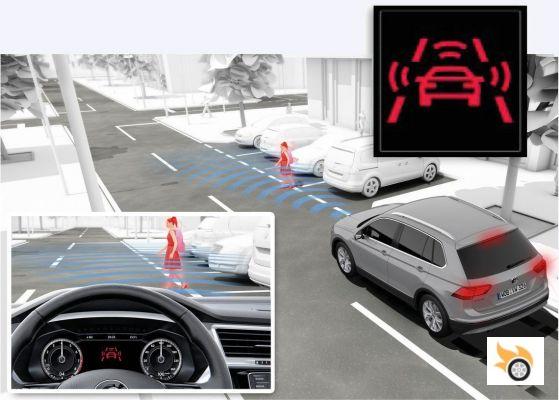
And, finally, mention the panoply of security systems that has the car, already seen in other models of the brand, such as fatigue assistant, blind spot vehicle, reading traffic signs, rear cross-traffic assistant, automatic braking in city and a very long etcetera. All these advances leave the previous Tiguan in the most absolute obsolescence. As always, we will have to be careful with how many extras we put in the car, but more than a matter of weight, for what we will have to spend more in euros. In this sense, the Tiguan is like a premium product.
